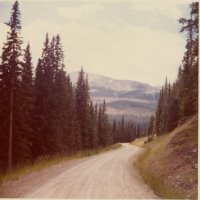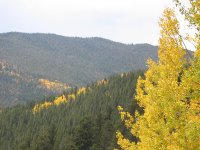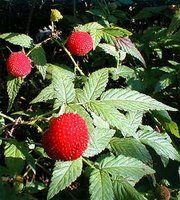Monday, January 05, 2009
Sunday, September 17, 2006
Mountain Road

Some of the best drives are on mountain roads in the Colorado Rockies. The most interesting of these are the backcountry dirt-and-gravel byways that bob and weave through a beautiful variety of scenes.
One of these roads begins with an exit from a small paved highway in the foothills of north central Colorado. Immediately, the road leaves the sagebrush and hayfield environment and seems to disappear into a hidden small canyon. Beginning with the first sharp turn, seldom can the driver see more than a short distance of twenty or thirty yards of the road at a time, with many narrow and blind curves. A small stream runs parallel to the road, but can be viewed only in quick glances through the thick willow growth lining both the streambed and the roadbed. The road surface is hard-packed, but dusty, with washboard bumps that keep vehicle speeds to a slow pace. An occasional damp area, in deep shade, recalls a light rain shower from the previous day.
The willows grow thicker and taller, filling around an occasional ancient cottonwood tree, whose shiny dark green leaves twirling in the light breeze promise refreshing shade. The deep-grooved, rough bark of the sturdy cottonwood contrasts sharply with the smooth and lithe branches of the willow. Both plants advertise the presence of water, a welcome sign in a dry land.
The road often narrows to hardly more than a lane in width, but two vehicles can usually meet safely, with care. The maintenance crew has graded small pull-offs whenever possible, each just large enough for one vehicle to stop out of traffic’s way.
Traveling upstream, the road begins to climb in elevation, hardly perceptible at first. Suddenly, one of the sharp curves in the road completely doubles back on itself, creating a hairpin turn and a steep incline. The road gains altitude quickly. With the increasing elevation, the road leaves the stream, and the vegetation near the road changes dramatically. Willows and cottonwoods give way to pine and spruce. The forest becomes thick, and individual tree trunks are visible only a short distance into it.
Switchbacks occur more frequently, and the roadbed sees little sunshine through the tall trees growing immediately next to the road. Eventually, the evergreen forest begins to thin, and aspen groves become common. The aspen’s white trunks and light green leaves reflect more sunlight toward the road. Green grass and colorful wildflowers decorate the aspen glens. A tiny snow-fed brook passes under the road, with miniature waterfalls on both sides. The road continues to climb and becomes rougher and more narrow. A striped ground squirrel darts in front of the vehicle and dives into a hole in the rocky slope beside the road. Eventually, the aspen trees give way to limber pines stunted and gnarled by the harsh high-altitude environment. Soon, no trees survive, and the long-bladed grass has been replaced with tundra and lichen-covered rocks; the road is above timberline. In the absence of shade, the sun and sky seem exceedingly brilliant, and a light breeze feels downright cold, even in the middle of summer.
In a dozen miles of twists and turns, the road has risen six thousand feet in altitude. The ecology of the roadside has changed noticeably several times. The view from the top of the high mountain pass is breathtaking, an experience enhanced by the crisp, thin air. The excursion was challenging and tiring, but worth every moment of effort and careful attention. No other short drive compares to this small mountain road in the Rockies.
Gerald McDaniel, September 2006
Saturday, September 16, 2006
The Eyes Have It

Human vision is amazing. I am in awe of what I can discern through my eyes. It is difficult to believe that I can see these things:
- the shape of an individual evergreen tree silhouetted on a mountain peak many miles away
- individual tiny striations between the larger lines in the skin on the palm of my hand
- the light from a single star many billions of miles away
- the nuances of overlaid hues in an impressionist oil painting
- the clear recognition of words and numbers on a small road sign I glimpse as I pass it at a speed of sixty-five miles per hour
- the indescribable iridescence of a butterfly wing or a thin oil slick on water
- the clearness of a tiny LED light on a piece of electronic equipment across a large room
- the movement of a small shadow among other shadows
- eye contact with another driver across a busy intersection
- a rainbow
I am truly amazed at what my eyes and brain can tell me about the world.
Gerald McDaniel, September 2006
{clip art from webweaver}

Autumn Notes in the Rocky Mountains

The earthy smell of pine logs burning in a fireplace.
Splashes of brilliant aspen groves highlighting dark evergreen forests.
Powdered sugar dusting of snow on bald rocky peaks.
Red apples, orange pumpkins, green acorn squash, and purple Indian corn.
Elk bugling; geese honking.
Thin crystal ice crusting edges of small brooks.
Leaves of every hue drifting, rolling, floating on wind and river currents.
A crispness in the air heightens the senses; autumn has made its entrance upon the seasonal stage of the Rocky Mountains.
Gerald McDaniel, September 2006
{photo by Gerald McDaniel, 2006}
Sunday, January 22, 2006
Muddy Water
I watched the brown muddy water slowly swirling around the bend in the sluggish stream. An old snag log stuck up defiantly, causing eddies to circle it, trapping a dead leaf and a small twig in an unending whirlpool.
A weeping willow tree overhung the grassy bank, dipping several long, flexible limbs into the water. The willow leaves appeared to be filtering the flowing water, as though fishing for something to catch.
In a still area of the stream’s curve, water skimmers skated on the surface, as though it was smooth chocolate-colored ice. They skittered hither and yon, but seemed to accomplish nothing.
Some cottonwood seed tufts floated by, like miniature powder-puff barges, bereft of cargo. A small piece of tree bark navigated in the swifter current near the middle of the stream, with a swallowtail butterfly perched precariously on it, seeming to pilot it safely through the shoals.
Occasionally a family of bubbles drifted along, clinging together and clutching at some stray blades of grass drooping into the edge of the flow.
A small host of black gnats tirelessly circled the quiet edge of the water, as tiny wavelets ineffectively slapped at the muddy side of the dark bank beneath them.
I suspected a fast and treacherous current moved in the depths of the stream, out of my perception, although the surface seemed so calm and predictable.
As I pondered this parade of flotsam interacting with the stationary features of the bank and with the stubborn snag, I wondered how often the same scenario played out, over time. How much did the stream, the bank, the snag, and the other members of the scene change, and how much did they remain the same? If I sat at this spot for a decade, would I notice a significant difference in its appearance each day, or would the constantly-altering physical features change so imperceptibly that I could not detect it?
Was I like the stream and the bank – did I change slowly, yet inexorably? Were there dangerous currents below my unperturbed surface? Did I carry a plethora of flotsam, as I made my way through each day?
I felt a kinship with the stream. I was also opaque, sometimes swirling, sometimes calm, carrying tiny burdens, participating in the process of life, often appearing single-minded and uncaring, and continuously eroding what tried to contain me. Would I reach a climactic outpouring, merging into the larger river of life, contributing some rich sediment to history? Or, would I meander onto a broad plain, losing my force of will, until I gradually soaked into the muddy marshland and disappeared from notice?
Thus, I spent an afternoon contemplating a muddy stream and my life.
Gerald McDaniel, October 2003
Wind in the Pines
The wind in the pines makes a haunting sound. It seems to whisper through the tops of the tall trees, just brushing the tips of the branches. It sings gently through the needles, like a musician blowing on an instrument’s reed. The sound is hardly noticeable, when the breeze is light; but when the velocity increases, the whoosh sound of the limbs brushing against each other is like a straw broom whisking across a rough stone floor. The noise of the higher winds conjures images of ghosts, the unknown, and danger, but the soothing sound of the light breezes can lull me to sleep. I cannot imagine a sound more relaxing than that of a gentle breath of wind in the tops of the pines.
Gerald McDaniel, October 2003
The Plains Wind
I detest the wind on the plains. It covers me with dust and pollen. It takes advantage of my allergies and attacks me through my eyes, my nose, and my lungs. It throws missiles at me – leaves, tumbleweeds, seed tufts, loose paper, and other debris. It leaves me uncomfortable, feeling disheveled and dirty.
The wind on the plains is like an invisible enemy. It can surround me in a swirl, or it can blast me in my face, my back, or my side, in an all-out attack. It sometimes blows straight and strong, unrelenting. Other times, it comes in heavy gusts, often from different directions, with lighter force between the bursts. It doesn’t fight fairly! My only recourse is to hide from it; I have no means to retaliate against it.
I know the wind serves some useful purposes. It clears away air pollution, dead leaves and branches from trees, airborne insects, and human litter. But, it’s not an effective cleaner – it simply moves this trash from one place to another, like sweeping dirt under a rug. The only pleasant accomplishment it achieves is to activate the wind chimes I have hung. That’s the only way for me to gain anything from the onslaught of the wind on the plains.
Gerald McDaniel, October 2003
Contrasting Similarities
¨ Note the coolness of the air in the dark tree shade in the mountains; note the heat in the air in the brilliant sunshine in the mountains: it’s the same air.
¨ Arrowheads are made of smooth, glassy flint or obsidian; arrowheads are made of coarse, rough quartzite: both are arrowheads, created and used for the same purpose.
¨ Feel the sticky, glue-like, fresh pitch on an evergreen tree; feel the smooth, glass-like, hard, dry pitch: it’s the same sap on the same tree.
¨ Walk on the dusty, powdery-dry dirt in the mountain road; slide on the slippery-when-wet mud in the mountain road: it’s the same soil on the same road.
¨ Caress the soft, pliable, new spruce needles; carefully touch the stiff, sharp-pointed, mature spruce needles: they are the same needles on the same tree.
¨ Climb on the hard, impervious granite cliff side; try to stand on the loose, almost flowing, weathered granite particles on the hillside: it’s the same granite.
¨ Admire the dark green summer aspen leaf; admire the light golden autumn aspen leaf: it’s the same leaf.
¨ Swim in the warm, soft water of the lake; skate on the cold, hard ice of the lake: it’s the same water in the same lake.
¨ Enjoy the noisy sounds of children dear to you; flinch from the noise of children who annoy you: they are essentially the same sounds.
¨ Feel pleasure from the touch of someone you love; recoil from the touch of a stranger: both are human touches.
¨ Gently pressing ice to an injury on your head is comforting; falling and hitting your head on ice causes injury and is discomforting: both involve the meeting of your head and ice.
¨ Relax in the absolute stillness of the air; try to stand in the face of a gale-force wind: it’s the same air.
Hope for the best in life; be not surprised by the worst in life:
it’s the same life.
Gerald McDaniel, October 2003
Mountain Stream
I am mesmerized by a mountain stream moving rapidly through a pine forest. The crystal clear water is like flowing glass, throwing tiny, random reflections of sunlight from its surface. In a shady area beneath the branches of an over-hanging evergreen, I can see the brown bottom of the streambed, covered with small, smooth stones of various colors. Large boulders hold steadfast in the current, causing deep pools to form downstream of them. The water appears to stand still in those depths, but it is secretly flowing in and out, as if by magic.
Smaller boulders in mid-stream cause sprays of water to fly into the air, creating bubbles in the current and sending tiny waves against the shore. The fountains of water from these obstructions pulse, now strong, now weak. I wonder whether any two of the sprays are ever the same, with all the droplets cascading in exactly the same manner. I doubt it, but stranger things have happened in this world.
The water is icy cold, fresh from snow banks higher up the mountainsides. In older times, it was safe to drink and was immensely refreshing. It was so cold that it hurt my teeth. Now, it has to be boiled or treated before it can be ingested safely. What a loss!
Although it is not always apparent, the current is swift. If I tried to wade across it, I would run the very real risk of losing my footing and being swept away. It may look benign, but there is danger lurking within its depths and its powerful gravity-fed force. In the spring melt season and at times of sudden downpours, the stream is capable of moving large boulders and of carrying sizeable tree trunks many miles downstream. Each year, it undermines a number of huge trees, and causes them to slip into the stream’s domain. It may appear to be an innocent, safe feature of this environment, but its disguise is misleading. It can be a truly destructive force.
The sound of the rushing water, as it falls over sunken logs, crashes against huge boulders, and bubbles over rocks just below the surface, is music to my ears. Its noise is a cacophony -- boisterous, riotous, discordant, and chaotic; but it is like a beautiful symphony to me. As I sit on the bank, with my eyes closed, I hear a song of nature, wilderness, strength, and peace. The sound is soothing; it blocks out all other noises and allows me to concentrate on whatever my mind chooses. It does not distract me, but places a protective barrier around me, screening out other sounds that might disturb me. I find my thoughts drifting, stretching, relaxing, and I enjoy the sense of well-being produced by the solitude of the moment. What a wonderful therapy this mountain stream is for my psyche!
Gerald McDaniel, October 2003
Aspen
I see a forest of quaking aspen – white-barked boles tattooed with black scars caused by injuries. The tiny tender stems twirl flat, waxy, round, rough-edged leaves, even when no air movement seems present. Yes, I have carved my initials and calendar dates into the paper-white cover of several of these forest denizens. It was an effort for immortality -- a futile effort, of course. Trees die, burn, or are cut down and removed. My crude symbols have surely disappeared long ago. Disturbing, isn’t it?
An aspen glen is pure refreshment in a gentle breeze. The movement of the thousands of tiny leaf fans is pleasant to observe; it makes me believe the air is cooler than it really is. The flickering leaves reflect sunlight into the dark shadows -- shadows which are also created by the same leaves. Curious, isn’t it?
All of the tree trunks in this area are connected by common roots; this entire forest is composed of a single tree. Is this one plant aware of the death or disfigurement of one of its member parts? Does it feel a sense of loss? Has it noticed my act of carving into its woody tissue with my sharp hunting knife? Does any destructive action go unnoticed by this arboreal wonder? It demonstrates no signs of pain or discomfort. Amazing, isn’t it?
The color-turning trick of the aspen entertains us each autumn. Why do certain small branches hold leaves that become brilliant orange, while others adjacent to them are golden, green, red, brown, or black? Perhaps this is a method of communication among the trees, with the color arrangements holding meanings that are incomprehensible to us. Do these semaphore patterns signal data to other aspen forests? Haunting, isn’t it?
How can these deciduous plants lose their livelihood each fall and expect to return to life each spring? Of course, some do not complete the cycle, but most do. The miracle of life is strongly present in these groves. Reassuring, isn’t it?
Gerald McDaniel, October 2003

